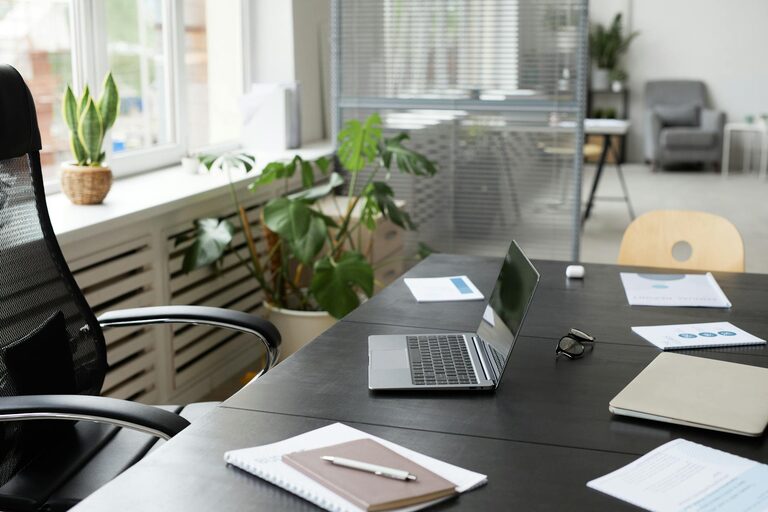Desk Setup Tips for Focus and Comfort: Create Your Ideal Workspace

Creating an effective workspace is essential for staying focused and comfortable throughout your workday. Whether you work from home or in an office, your desk setup can significantly influence your productivity, mood, and overall well-being. In this post, we’ll explore practical desk setup tips that help you maintain focus and comfort, turning your desk into a space where you can thrive.
Why Your Desk Setup Matters
Your desk setup is more than just arranging furniture; it’s about designing an environment that supports your physical health and mental focus. An ergonomic and organized desk can reduce strain on your body, prevent distractions, and create a positive atmosphere that encourages productivity.
Essential Elements for a Focused and Comfortable Desk Setup
1. Choose the Right Desk and Chair
Your desk and chair form the foundation of your workspace comfort.
– Desk height: Aim for a desk height where your elbows are at a 90-degree angle when typing. Standard desk heights range from 28 to 30 inches.
– Chair ergonomics: Select a chair with adjustable height, lumbar support, and comfortable cushioning. Proper support helps you maintain good posture and reduces back pain.
– Foot positioning: Your feet should rest flat on the floor or on a footrest to avoid strain.
2. Position Your Monitor Correctly
The placement of your monitor plays a big role in reducing eye strain and neck pain.
– Position the monitor about an arm’s length away from you.
– The top of the screen should be at or slightly below eye level.
– Tilt the screen slightly upward for comfortable viewing.
– Use a stand or adjustable arm if needed to achieve the correct height.
3. Optimize Lighting
Good lighting can reduce eye fatigue and improve focus.
– Use natural light whenever possible, but avoid glare on your screen.
– Position your desk perpendicular to windows to balance natural light.
– Add a desk lamp with adjustable brightness for cloudy days or late work sessions.
– Choose light bulbs with a natural white light for a calming effect.
4. Keep Your Desk Organized
A cluttered desk can distract and stress you out. Maintaining order supports mental clarity.
– Use organizers like trays, drawer dividers, or containers.
– Only keep essentials on your desk—store other items elsewhere.
– Regularly declutter your workspace to avoid build-up.
– Consider cable management solutions to keep wires tidy and out of the way.
5. Incorporate Comfort Accessories
Small accessories can enhance comfort and reduce fatigue.
– Use a wrist rest for keyboard and mouse to prevent strain.
– Place a soft desk mat for comfort and style.
– Keep a water bottle nearby to stay hydrated.
– Add a small plant to improve air quality and create a calming vibe.
Tips for Maintaining Focus at Your Desk
1. Minimize Distractions
– Use noise-canceling headphones or play soft background music if noise is a problem.
– Keep your phone on silent or in another room to avoid interruptions.
– Limit non-work-related items in your line of sight.
2. Personalize Your Space Thoughtfully
A workspace tailored to your tastes can boost motivation.
– Add a few meaningful photos or art pieces, but avoid overcrowding.
– Choose calming colors or accents that make you feel relaxed.
– Use scents like essential oils or candles cautiously—overpowering smells can be distracting.
3. Use Tools to Track Time and Tasks
– Utilize planners or digital apps to manage tasks.
– Try the Pomodoro Technique—work in focused intervals with short breaks.
– Set goals for each work session to stay on track.
Ergonomics and Health Considerations
Standing desks are becoming popular for promoting movement. If using one, alternate between sitting and standing every 30 to 60 minutes. Make sure to wear supportive shoes to reduce foot fatigue.
Remember to take regular breaks:
– Look away from your screen every 20 minutes (the 20-20-20 rule).
– Stand up and stretch or walk around at least once an hour.
– Practice simple stretches to release tension in your neck, shoulders, and back.
Final Thoughts
Designing a desk setup that encourages focus and comfort is a personal journey. By paying attention to ergonomics, lighting, organization, and personalization, you can create a workspace that not only supports your productivity but also enhances your enjoyment and well-being at work. Start today by making small adjustments and notice how they impact your workday!
—
Feel free to share your own desk setup tips and photos in the comments. Happy organizing!




